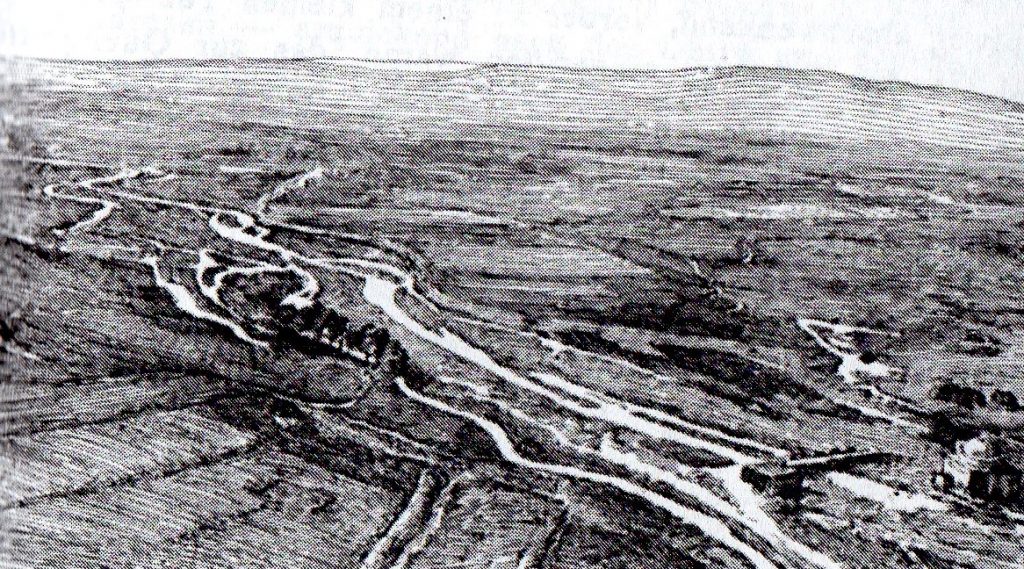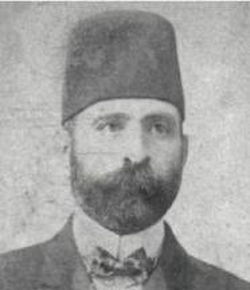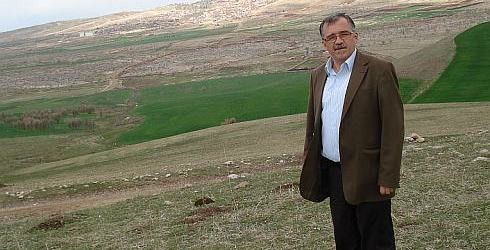
Population
In 1914, there lived 5,980 Armenians in 33 localities of the kaza, half of them in the administrative center. They maintained 24 churches, one monastery and five schools with 305 students.[1] The number of Orthodox Syriacs in the kaza was 1,980.[2] The total Assyro-Chaldean population of the kaza was given as 4,100 persons.[3]
According to David Gaunt, the inhabitants of the administrative seat of Lice numbered 12,000, of whom 7,000 were Christians (Armenians, Chaldean, Syriac Orthodox).[4]
Destruction
“The orders concerning the Armenians were apparently contested in this area as well by Hüseyin Nesimi Bey, the kaymakam of Lice, who was executed on instructions from the vali of Dyarbekir. Subsequent events seem to have followed the usual pattern. According to a secret report by the head of the Administration of the Public Debt in Lice and a Catholic Syriac, Namam Adamo, house searches were first conducted with a view to finding arms. They were followed by the arrests of the notables, who were assassinated in caverns located further south in Daştapise. Next came the elimination of all males over ten and finally, the deportation of women and children. The men still present in the Taurus mountain villages seem to have been massacred where they were found. We do not know what became of the women and children.”[5]
In an estimate presented at the Paris Peace Conference (1919), the Syriac Orthodox Patriarchate put the number of massacred Syriac Orthodox Christians in the kaza Lice at 4,706 and the number of destroyed villages at 10.[6]
David Gaunt: Massacres and deportations
„(…) At once, guards were placed outside the homes of all Christian notables, and all Christian civil servants were fired from their jobs. The following day, 50 representatives of the Christians were marched outside the town and slaughtered by Kurds at a place known as Dashta-Pis, near Diyarbekir, where the corpses were placed in caves. Among those killed were the Syriac priests from Qarabash and Ka’biye, who had been jailed in Lije. After this there was a second mass arrest, which included several priests, followed by mass executions. Gangs of çetes [irregulars] massacred and plundered the neighboring Christian villages: Fum, Chemchen, Jum, Tappa, Nagle, Pasor and Khaneke. (…) The destruction was done before the holiday of Ramadan began (mid-July), and during the holiday month no further massacres took place. However, when Ramadan was over, the murders resumed again. As the males had been disposed of, the activities focused on the women and children, who were deported.”
Excerpted from: Gaunt, David: Massacres, Resistance, Protectors: Muslim-Christian Relations in Eastern Anatolia During World War I. Piscataway, NJ: Gorgias Press, 2006, p. 236
Hüseyin Nesîmi Bey (1868 – 23 June 1915) – Kaymakam of Lice: “I will not participate in this sin!”

Hüseyin Nesîmi Bey was born in 1868 in Chania on the island of Crete. He was the son of the religious scholar Fatinzade Ahmet Ata Efendi of the Kadîrî order. As his son Abidin (according to some sources Abdin) Nesîmi noted in his memoirs, Hüseyin Nesîmi had internalized the socialist-participatory-humanist worldview and was close to the Bektashi Order.
During his studies at the College of Politics, Hüseyin Nesîmi took part in revolutionary actions, which temporarily deprived him of the right to be a civil servant. Not until 1901, when Abdülhamit II was pleased with his development plan, he was granted this right again.
Hüseyin Nesîmi Bey first began working as a scribe in 1890 and rose to the position of Assistant for Economic Documentation in the province of Crete in 1893, and in 1899 he became the main documentarist in the mayor’s office of the city of Chania. In 1901 he was forcibly transferred to the District Office of Palu and resigned. Until the proclamation of the Constitutional Monarchy in 1908, he exercised independent activities in the Ottoman capital Constantinople. From 1909 on, he was a county councilor in the counties of Navervan, Tercan (formerly Mamahatun, Erzurum Province; today Erzincan Province), Kiğı (Diyarbekir Province; today Bingöl Province), Vilçetrin and Premedi.[7] In April 1914 he was sent to Savur and on 13 January 1915 to Lice (province Diyarbekir).
Hüseyin Nesîmi never distanced himself from the socialist-participatory ideology. In 1900, he played a decisive role in the founding of the National Humanist Association and became its chairman. Among other things, he advocated the founding of an independent Caucasus state, including Armenian settlement areas, between Tsarist Russia and the Ottoman Empire.
During his term of office in Lice, Hüseyin Nesîmi Bey became aware of the order issued by the governor of Diyarbekır, Dr. Reşit Şahingiray to kill the Armenians. Therefore, he contacted persons of his trust to obtain guarantees of protection for the Armenians. At the same time, he tried to carry out the deportations in a way that neither Armenians nor Chaldeans were harmed. It is said that he accompanied the deportation trains and handed the deportees over to his trusted confidants, with whom they found protection.
Nesîmi Bey once said: “I will not participate in this sin!” Shortly after this statement, he was summoned to Diyarbekir by the Vali Reşit and was murdered by an officer of the ‘Special Organization’ in a mountain ravine on the order of Reşit. This murder was described in the media as follows: “He was raised to the status of a martyr in the pursuit of irregular fighters on 15 Haziran 1331 [15 June 1915] during an attack by Armenian irregulars.”

In 2011, a team of journalists, including Oral Çalışlar, succeeded in finding the remains of Hüseyin Nesîmi’s grave. It is located near Karaz (Kocaköy) in Diyarbakır. During the research, the team found out that this site is still known among the people as ‘Tirbe Queymaqam’ (Holy Shrine of the District Administrator).
In total, an above-average number of land councils and mutasarrifs (district governors) – half of all such officials – in the Ottoman province Diyarbekir have resisted or tried to resist the murderous orders of the provincial governor Reşit. The French-Armenian historian Raymond Kévorkian suspects the reason for this in the fact that Reşit apparently acted in such blatant contradiction to the existing legal situation that the subordinate officials demanded the submission of corresponding written orders from the central government in order to secure themselves.
The result, however, was that the recalcitrant officials were dismissed or even executed or murdered: In addition to three executed officials, Mehmet [Muhammet] Hamdi Bey was replaced as head of Çermik County (Kaza) by Ferik Bey on 1 July 1915. Mehmet Ali Bey, the Savur county governor, remained in office only from 2 May to 1 October 1915, and Ibrahim Hakkι Bey, the Silvan county governor, was dismissed on 31 August 1915[8], as were the successive county governors of Mardin, Hilmi Bey (dismissed 25 May 1915) and Şefik Bey (dismissed June 1915), because they too had refused to carry out the extermination orders of the provincial governor Reşit.[9] The district governor of Derik County (province Diyarbekir), Reşit Bey, who was in office from 12 October 1914 to 2 May 1915, was not only dismissed, but murdered on the road to Diyarbekir by the Circassian bodyguards of the governor Dr. Mehmet Reşit. As in the case of Hüseyin Nesîmi, his murder was blamed on the Armenians. It even served as a pretext for the elimination of the Armenian men in Derik county and the subsequent deportation.
Sources: https://www.aga-online.org/aga-archiv/beitraege/verschwiegene-helden/hueseyin-nesimi-bey/
Abbasoğlu, Doğan Barış: Lice katliamı ve Hüseyin Nesîmi Bey. ANF News Agency, 01.05.2010.
Çalışlar, Oral: Türkiye’nin Vicdanı Bu Toprakta. Radikal Gazetesi, 29.05.2011.
Çalışlar, Oral: Öldürülen Lice Kaymakamı Nesîmi’nin Hayatı. Radikal Gazetesi, 01.06.2011.
Diken, Şeyhmuz: ‘Kaymakam Ermeniydi, Öldürdüler…’. Diyarbakır BİA Haber Merkezi. 23.04.2011.
Ekinci, Tarık Ziya: Lice’den Paris’e Anılarım. İstanbul, 2010.
Gust, Wolfgang: Alman Belgeleri: Ermeni Soykırımı 1915-1916. İstanbul, 2012.
Kévorkian, Raymond: The Armenian Genocide: A Complete History. London, New York 2011, pp. 363 and 368
Nesîmi, Abidin [Sohn des Hüseyin Nesimi]: Yılların İçinden. İstanbul, 1977